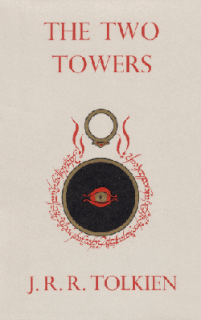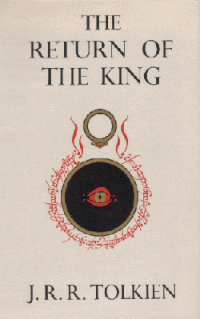Gandalf is a fictional character and a protagonist in J. R. R. Tolkien's novels The Hobbit, The Lord of the Rings and The Silmarillion. He is a wizard, member of the Istari order, as well as leader of the Fellowship of the Ring and the Army of the West. In The Lord of the Rings, he is initially known as Gandalf the Grey, but he returns from death as Gandalf the White.
Denethor II, son of Ecthelion II, is a fictional character in J. R. R. Tolkien's The Return of the King, which is the third and final part of his novel The Lord of the Rings. He is the 26th Ruling Steward of Gondor.
A palantír is a fictional magical artefact from J. R. R. Tolkien's Middle-earth legendarium. A palantír is described as a ball of indestructible crystal, used for communication and to see events in other parts of the world, whether past or future.

The Two Towers is the second volume of J. R. R. Tolkien's high fantasy novel The Lord of the Rings. It is preceded by The Fellowship of the Ring and followed by The Return of the King.

The Return of the King is the third and final volume of J. R. R. Tolkien's The Lord of the Rings, following The Fellowship of the Ring and The Two Towers. The story begins in the kingdom of Gondor, which is soon to be attacked by the Dark Lord Sauron.

The Lord of the Rings: The Return of the King is a 2003 epic fantasy adventure film directed by Peter Jackson, based on the third volume of J. R. R. Tolkien's The Lord of the Rings. The film is the third instalment in The Lord of the Rings trilogy and was produced by Barrie M. Osborne, Jackson and Fran Walsh, and written by Walsh, Philippa Boyens and Jackson. The film features an ensemble cast including Elijah Wood, Ian McKellen, Liv Tyler, Viggo Mortensen, Sean Astin, Cate Blanchett, John Rhys-Davies, Bernard Hill, Billy Boyd, Dominic Monaghan, Orlando Bloom, Hugo Weaving, Miranda Otto, David Wenham, Karl Urban, John Noble, Andy Serkis, Ian Holm, and Sean Bean. It was preceded by The Fellowship of the Ring (2001) and The Two Towers (2002).
In J. R. R. Tolkien's Legendarium, the Battle of the Pelennor Fields [pɛˈlɛnnɔr] is the battle for the city of Minas Tirith between the forces of Gondor and its allies, and the forces of the Dark Lord Sauron. Tolkien recounts this battle in The Return of the King, the third volume of his 1954–55 novel The Lord of the Rings as originally printed. It is the largest battle and one of the most important events of the War of the Ring, the war in which the Third Age of Middle-earth comes to a close. It takes place on 15th 'March' T.A. 3019 in the Pelennor Fields, the townlands and fields between Minas Tirith and the River Anduin. The concept and history of composition of the battle is detailed in the fourth volume of The History of the Lord of the Rings.

The Lord of the Rings is a film series of three epic fantasy adventure films directed by Peter Jackson, based on the novel written by J. R. R. Tolkien. The films are subtitled The Fellowship of the Ring (2001), The Two Towers (2002) and The Return of the King (2003). Produced and distributed by New Line Cinema with the co-production of WingNut Films, it is an international venture between New Zealand and the United States. The films feature an ensemble cast including Elijah Wood, Ian McKellen, Liv Tyler, Viggo Mortensen, Sean Astin, Cate Blanchett, John Rhys-Davies, Christopher Lee, Billy Boyd, Dominic Monaghan, Orlando Bloom, Hugo Weaving, Andy Serkis and Sean Bean.

The Return of the King, is a 1979 animated musical television film created by Rankin/Bass and Topcraft. The film is an adaptation of The Return of the King, the third and final book in The Lord of the Rings by J. R. R. Tolkien.

In 1981 BBC Radio 4 produced a dramatisation of J. R. R. Tolkien's The Lord of the Rings in 26 half-hour stereo installments. The novel had previously been adapted as a 12-part BBC Radio adaptation in 1955 and 1956, and a 1979 production by The Mind's Eye for National Public Radio in the USA.
The following outline is provided as an overview of and topical guide to the real-world history and notable fictional elements of J. R. R. Tolkien's fantasy universe.
"A Walking Song" is a poem in the form of a song from J. R. R. Tolkien's fantasy novel The Lord of the Rings, originally published in three volumes. It appears in the third chapter of the novel, entitled "Three is Company"; usually as part of the first volume, The Fellowship of the Ring. It is given its title in an index to songs and poems usually published in the third volume, The Return of the King.
Saruman the White is a fictional character and a major antagonist in J. R. R. Tolkien's fantasy novel The Lord of the Rings. He is leader of the Istari, wizards sent to Middle-earth in human form by the godlike Valar to challenge Sauron, the main antagonist of the novel, but eventually he desires Sauron's power for himself and tries to take over Middle-earth by force. His schemes feature prominently in the second volume, The Two Towers, and at the end of the third volume, The Return of the King. His earlier history is given briefly in the posthumously published The Silmarillion and Unfinished Tales.
Gimli is a fictional character from J. R. R. Tolkien's Middle-earth legendarium, featured in The Lord of the Rings. A dwarf warrior, he is the son of Glóin.
Meriadoc Brandybuck, usually called Merry, is a fictional character from J. R. R. Tolkien's Middle-earth legendarium, featured throughout his most famous work, The Lord of the Rings. Merry is described as one of the closest friends of Frodo Baggins, the main protagonist. Merry and his friend Pippin are members of the Fellowship of the Ring. They become separated from the rest of the group and spend much of The Two Towers making their own decisions. By the time of The Return of the King, Merry has enlisted in the army of Rohan as an esquire to King Théoden, in whose service he fights during the War of the Ring. After the war, he returns home, where he and Pippin lead the Scouring of the Shire, ridding it of Saruman's influence.

The Lord of the Rings: Aragorn's Quest is a 2010 action-adventure video game developed by Headstrong Games for Wii, PlayStation 2, PlayStation 3 and PlayStation Portable and TT Fusion for Nintendo DS. It was published on all platforms by WB Games.
Aragorn II, son of Arathorn is a fictional character from J. R. R. Tolkien's legendarium. He is one of the main protagonists of The Lord of the Rings. Aragorn was a Ranger of the North, first introduced with the name Strider at Bree, as the Hobbits continued to call him throughout The Lord of the Rings. He was eventually revealed to be the heir of Isildur and rightful claimant to the thrones of Arnor and Gondor. He was also a confidant of Gandalf and an integral part of the quest to destroy the One Ring and defeat the Dark Lord Sauron.
Frodo Baggins is a fictional character in J. R. R. Tolkien's legendarium, and the main protagonist of The Lord of the Rings. Frodo is a hobbit of the Shire who inherits the One Ring from his cousin Bilbo Baggins and undertakes the quest to destroy it in the fires of Mount Doom. He is also mentioned in Tolkien's posthumously published works, The Silmarillion and Unfinished Tales.

The Fellowship of the Ring is the first of three volumes of the epic novel The Lord of the Rings by the English author J. R. R. Tolkien. It is followed by The Two Towers and The Return of the King. It takes place in the fictional universe of Middle-earth. It was originally published on 29 July 1954 in the United Kingdom.









